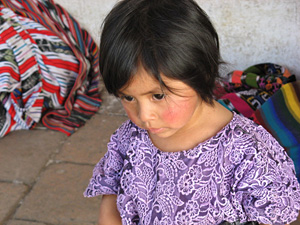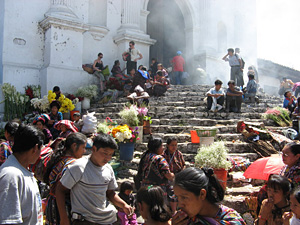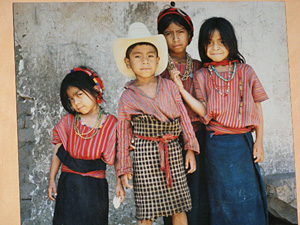 |
 |
 |
 Travel & Outdoors | April 2007 Travel & Outdoors | April 2007  
Adventures in Guatemala
 Judy Parks - PVNN Judy Parks - PVNN

A shadow of themselves
Reveals them straight and tall
Their ancestors created a Mayan civilization
Archaeologists still asking... why did it fall?

Desperately hanging on to their traditions
Twenty-two Guatemalan Indian tribes still exist
They respect the lifestyle of those who came before them
Many are not interested in change... THEY RESIST!

As I entered the village of Chichicastenango I could feel the muscles in my body tighten up like I'd pushed a familiar button to release a shield of protection. I wasn't prepared for the scene before me and as the bus pulled away I was thinking maybe I should have stayed on it and kept going.


| | "Who am I in this life? What opportunities are there for me?" | 
| | Steps leading up to Santo Tomas Church in Chichicastenango. | 
| | Example of ethnic dress, as photographed from an old photo on the wall of Antiqua Coffee Plantation. |
But why would I want to have stayed on that bus? The two-hour drive from Antigua, on the paved two-lane Pan American Highway 'numero uno,' was intense to say the least. Crammed into a 15-passenger bus with most of our luggage and parcels strapped onto the top was a down right 'hair raising' experience.

The two lanes had been bursting with fast moving cars, trucks and buses in both directions as well as horse drawn wagons, carts, bicycles, three wheeled vehicles, and people on foot carrying their load on their backs or on top of their heads. No rules seemed to apply when passing one another - the near accidents were many - as a passenger, I finally resorted to 'letting go of worry' and 'embracing my faith' because it was clear there was nothing I could do to make things safer.

I wasn't prepared for the contrast from where I had been and where this bus had delivered me. It only took 2 hours of 'hell on wheels' to get me here and it felt like I stepped back in time 200 years!

Upon my arrival in Guatemala City, three days before, I was quickly placed in a taxi in the middle of the night and driven to Antigua. It was raining and visibility was poor, but the good news was that because it was late there was very little traffic.

I had read that Guatemala City was not safe for anyone, let alone a tourist. My American flight #1994 was to have landed in Guatemala during daylight hours but we were delayed 6 hours in Dallas.

The cab driver spoke no English so my Spanish was immediately put to the test. The good news was my driver had been instructed where to take me. It was well after midnight in Antigua when the cab pulled up to Hotel Casa Santo Domingo. I climbed out and entered through a carved double door entry with obvious ten-foot stonewalls on either side that extended as far as I could see in each direction.

This 5 Star Hotel was once a Monastery, built in the 1500's the open air halls, gardens and walk ways were lit only by candles of varied size (many candle holders were my size and larger and some very small to light the paths); I followed what looked like a bellhop and I found myself stumbling and reaching for the wall as I wound my way through the halls to the main check-in desk. With the many shadows on the walls, my imagination started to play tricks on me, and soon my leader was wearing a hooded cape and I was sure I'd been dropped off at the Monastery for my indoctrination to Catholicism in this Spanish built fortress.

It had been a long day since the alarm went off at 5 am in my San Francisco hotel room, so I was anxious to sign the registration forms and find my way to my room. If only they could turn on the lights so I could see what I was signing and where I was going.

By the time my 'assigned monk' left me at my room I was too exhausted to appreciate the beauty of my surroundings. I unpacked, took a quick shower, raided the small refrigerator in the room for something to munch on, brushed my teeth and thought about kneeling at my bedside to give thanks to God for getting me here safely - instead I climbed into bed and mumbled a prayer that was never finished because I fell sound asleep.

The Indian People of Guatemala, of which there are 22 ethnic groups and 22 different dialects, (Mam, Ixil & Kaqchikel to name three that I can barely pronounce) are desperately trying to hang on to their heritage and maintain their traditions passed down from one generation to another.

They resent being called 'Maya People' because they see themselves as different and separate tribes. Many of them do not want to become immersed and lost into the white man's world. "Unlike other parts of the world, in Guatemala, and certain other countries of Latin America the Indians are in the majority" - you'd think they'd have no problem taking a stand - not! To this day many are treated as second class-citizens and they have endured multiple atrocities to their people over the years in failed attempts to destroy them and their existence.

The setting in Chichicastenango seemed more like a movie set for a thriller, where an American tourist disappears somewhere under the multicolored canvasses that shade the colorful native market in the mountains of Quiche - a market that dates back to pre-Hispanic times where textiles and hand carved masks are the popular tourist items.

I could hear the shouts of vendors - "hawking his or her products in a riotous cacophony of color, dialects and costumes, smoke and smells" - no one would hear my screams for help when a rug is thrown over me and I'm lifted into the back of a moving pickup truck and carted off to be held for ransom or murdered because they think I'm here as part of a reported 'baby stealing ring.'

It is so crowded amongst the vendor's stalls that within seconds I was quickly separated from my traveling companions. I tend to be claustrophobic in small spaces, like elevators, but out in the open air I feel that same panic feeling set in if I'm shoulder to shoulder with a large group.

I made my way through the village of Chichicastenango and soon found myself standing in front of Santo Tomas Church, a church that dates back to the 1500's - there were so many natives I was lost in a sea of 'Maya' people that represented several different Indian tribes. Someone discerning would have been able to recognize the tribes by their dress, which was subtle to a novice.

The only thing that saved me from a panic attack was that my 5'4" height kept me at least a head taller than most of the people (and I'm considered short.) I encountered smells in the air - body odors (mine included as it was very warm,) food smells, flowers, and smoke from the burning of incense and candles at the entrance to the church where the Shaman were reciting their ritualistic prayers and swinging their incense burners back and forth in a cloud of smoke.

I'd read that on special occasions there might even be a 'chicken' sacrifice. The Spaniards had tried to convert the Indians to Catholicism - rather than create a problem many tribes adapted to Christianity but still practiced their prayer customs and their ritualistic worship of their Gods, which included the Sun and the Moon.

The 'Shaman' is very respected in 'Maya' culture; it's an honor to be selected by their village to travel to Chichicastenango and the Santo Tomas Church with the prayer requests of their people. In the past the 'Shaman' would take drugs to induce their capacity to connect with the Gods, now it's said that they use alcohol.

The ones that I saw were weathered and unkempt looking, like they hadn't slept in many days. One look at some of them and you'd swear they're on drugs, and it would be reasonable given the fact that the Guatemala 'drug' crop is one of the largest suppliers on the black market - the coco plant flourishes and produces cocaine and I'm sure marijuana (cannabis) is grown and readily available.

Later I would experience crops first-hand when I traveled to Sayaxche (a town reported to be one of the drug capitals) to see the newly discovered ruins of Ceibal in the Peten area southwest of Flores; and I would later read in the Guatemala City newspaper about the availability of cocaine on the streets of Guatemala City and in the discos at very low prices because 2006 was a record-growing year in Guatemala.

Standing at the base of the 18 stairs that led up to Santo Tomas (each stair represents a month in the Mayan calendar - 18 months - 20 days to a month) it seemed more like an out-of-body experience.

It wasn't until I removed myself from the location and viewed my digital photos that I realized the impact of my experience. Looking into the eyes of some of the children and especially the older women and men - I studied their expressions and their hands - aged, wrinkled and leather-like brown skin that seemed to speak of their survival stories, their difficult lives and the lives of their ancestors, lives made even more difficult by a government unsympathetic to who they were and are - 'SHADOWS OF THEMSELVES.'

Only 'Shaman' are allowed to enter the church through the main doors, everyone else climbs the stairs to the right of the entry and goes in through the courtyard which is the way I entered. The pews were filled with worshipers saying their prayers and in two locations inside the sanctuary there was a Shaman kneeled on a rug saying prayers and swinging an incense burner - they're heads covered and raising his and her arms to the heavens as they spoke to the God's. The prayers were as varied as the requests of the village people - I was told the prayers revolve mostly around deaths and illness within their village.

I'm glad the bus stopped here and that I had the courage to get off - I was happy to see the driver return, but had mixed emotions about getting back on the bus and navigating the road again! 'Chi Chi' will be with me for a long time - many of the faces I will never forget - it was an experience I will treasure.

It took a long time for my tense muscles to relax, and it didn't happen on the one-hour drive to Lake Atitlan. Driving down the winding road to the lake and seeing the active volcanoes surrounding the lake reminded me of the earthquake that occurred one year before that took out the narrow road that I was now traveling and closed off the lakeside native villages from the rest of Guatemala for several weeks.

Once inside my ground floor room, looking out at the Lake from my patio and the active volcanoes in the background, I was beginning to anticipate my next adventure in Guatemala and the tribal villages that I would visit by boat. | 
 | |
 |



